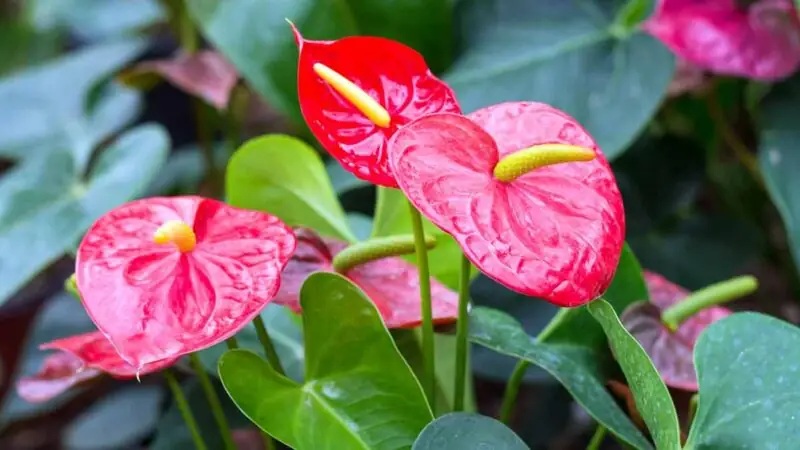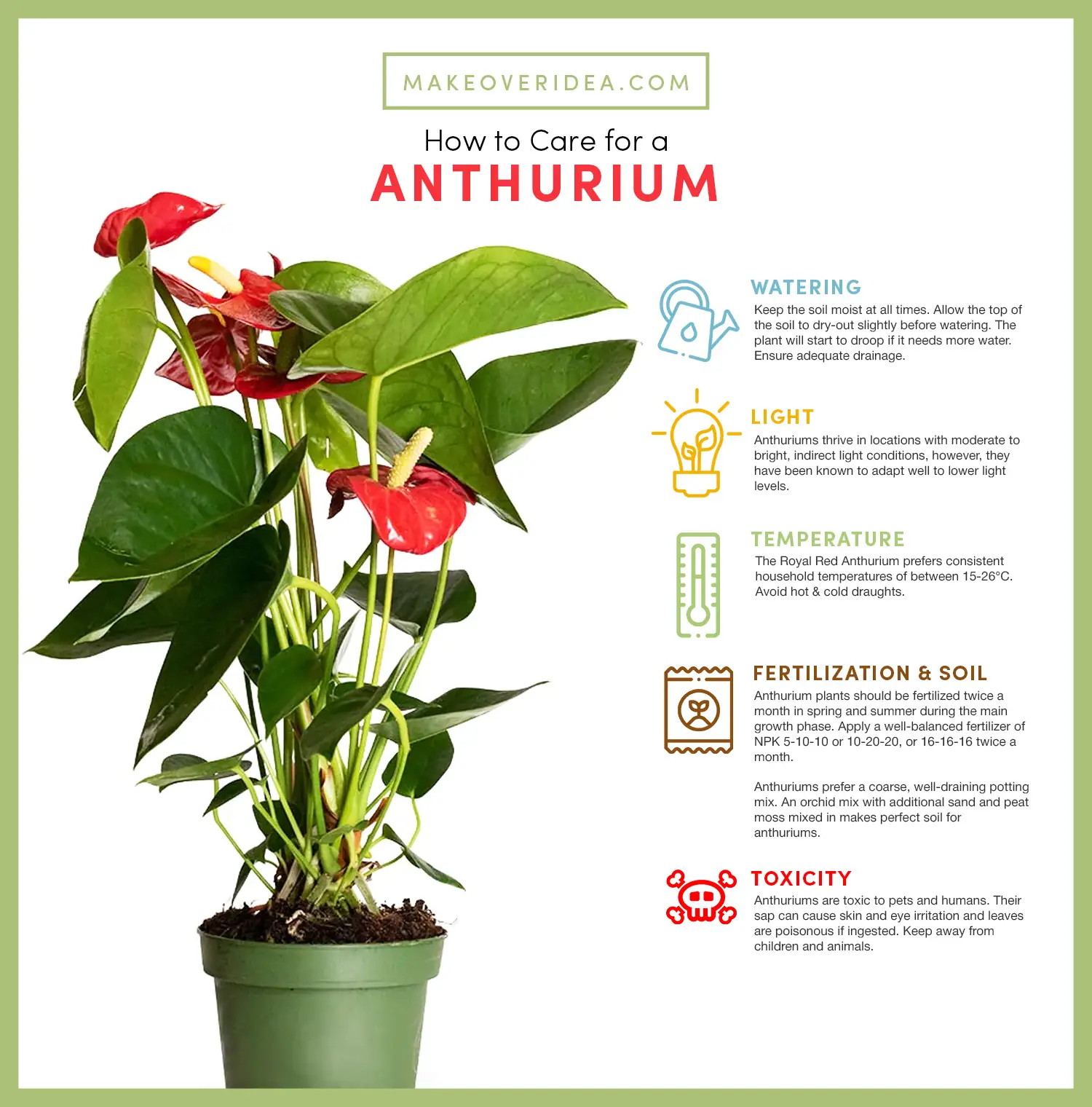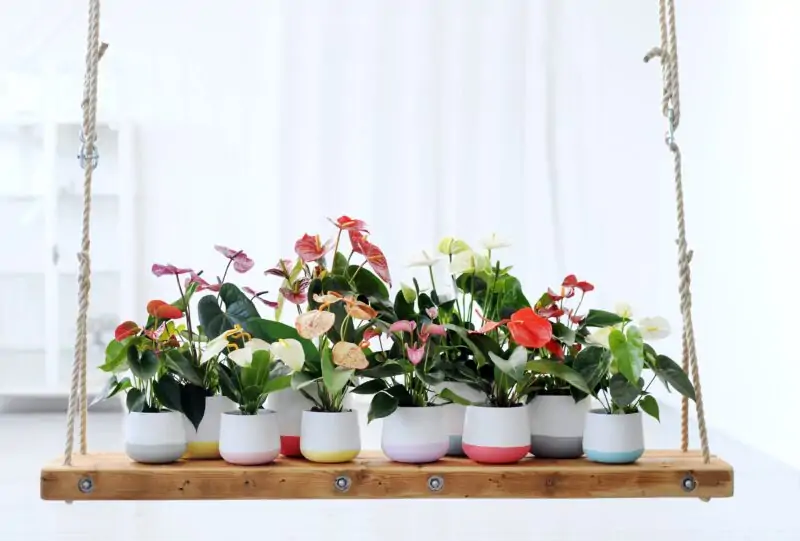How Long Do Anthurium Plants Live: Increase Lifespan Of Your Flamingo Flower

Are you the proud owner of anthuriums? These tropical plants are known for their beautiful flowers, vibrant colors, and unique shape. But how long do anthurium plants live and how do you ensure their longevity? In this article, we’re going to explore the lifespan of anthurium plants and share tips on how to extend it. From proper lighting to soil nutrition, we’ll cover everything you need to know about taking care of these stunning houseplants.
What Determines the Lifespan of Anthurium Plants?
When it comes down to it, there are three main factors that determine how long anthurium plants live: plant location and lighting, environment climate humidity, and quality of care and maintenance.
Plant Location and Lighting
The place where you put your flamingo flower is essential in determining its lifespan. Anthuriums are typically grown indoors as houseplants because they can’t handle frost or freezing temperatures outdoors. However, many people also grow them outside if they live in warmer climates where temperatures don’t drop below 60 degrees Fahrenheit at night.
Anthurium prefers bright indirect light, which means placing them near windows with sheer curtains works great! If too much direct sunlight hits the leaves, they may start wilting due to dehydration caused by excessive heat from the sun rays.
Environment, Climate, and Humidity
The humidity level is crucial for keeping these tropical beauties thriving. Inside homes located in dry regions, such as deserts, you may need to run humidifiers frequently to provide enough moisture necessary for their survival. Anthuriums do well with humidity levels between 80-90%.
Temperature also plays an important role. Ideally, keep the indoor temperature around 72 to 85 degrees Fahrenheit during the day and dropping 6 to 10 degrees lower at nighttime. In colder areas, you may need to use insulation or heaters to maintain the warmth required for sustained growth and a healthy flowering cycle.
Quality of Care and Maintenance
How well you care for your anthurium plant is just as essential to its lifespan. Proper watering, fertilization, pruning, and pest management are all critical components in ensuring a long life for your tropical houseplant.
- Water the plant every two or three days, depending on the humidity levels in the room. Make sure the soil doesn’t dry out completely before giving it another drink, but also don’t overwater because this can lead to root rot, which will quickly kill anthuriums!
- Fertilizer needs vary based on the growth period. Typically, use slow-release options during growing seasons and liquid feed once a month during the rest of the year. This helps keep the plants healthy, with strong and vibrant leaves and flowers.

How Long Do Flamingo Flower Typically Live?
On average, anthuriums have a lifespan of 3-5 years. If cared for correctly, they can potentially live for many years, flowering each season. When they are grown indoors under optimal conditions, their longevity increases significantly. Indoor plants can last up to six or seven years longer than outdoor ones. Factors like quality of care, maintenance, and climate play a huge role in determining how long anthuriums live, allowing these stunning blooms to provide beauty and enjoyment for households for years to come.
Indoor vs. Outdoor: Where Do Anthuriums Thrive Best?
Anthuriums thrive both indoors and outdoors, depending on location, climate, and environmental factors. Some people choose to grow them outside in warmer climates where temperatures stay above 60 degrees Fahrenheit at night. However, if it gets too cold, it can cause damage to the foliage and even death. Wilting and signs of stress can be seen quite early, and even experienced gardeners may struggle to keep them alive in harsher environments. So, it’s best to give your anthurium a chance to flourish inside your home by creating ideal living conditions. When watered and fed appropriately, and given enough indirect lighting, there’s no reason why your anthurium shouldn’t continue to delight your eyes and heart for several years!
How to Extend the Lifespan
If you want your plants to live longer, I’ve got some tips that’ll make ’em thrive. These tropical beauties are perfect for indoor growing, but getting them to last can be a challenge. But don’t worry – with proper care and attention, they can stick around for years!
Selecting Nutritious Soil for Anthuriums
First things first: when it comes to soil selection, quality is key. You want something that’s rich in nutrients and drains well, so your precious plants don’t get waterlogged.
When repotting or planting new anthuriums indoors or outdoors (depending on where you plan on keeping them), always opt for top-quality potting mix designed specifically for these tropical flowers.
Pro Tip: Mix perlite into the soil mixture before filling up the container. This helps improve drainage while still retaining moisture levels needed by anthuriums.
Providing Indirect Light
All living creatures need sunlight, even indoor ones like our flamingo flower friends. But too much direct light will burn their leaves, leading to wilt and plant death. Sunlight has UV rays, which may damage sensitive parts like petals, so it’s not recommended for anthurium flowers, especially during blooming season.
An indirect source of light, such as LED grow lights, provides enough energy without harming any part of a healthy plant’s growth cycle, ensuring strong stem development, vibrant leaves, and long-lasting blooms!
Consistent And Proper Watering Techniques
Keep the soil moist at all times; otherwise, wilting leads to dehydration, putting stress on the roots and causing a decline in health and overall lifespan. Water every 1-2 weeks, depending on climate and humidity level changes; adjust watering frequency accordingly if necessary!
Be sure to allow excess water to drain out from the bottom holes after watering, then remove the saucer beneath the container to avoid waterlogging and root rot. This method helps avoid overwatered soil, which could rot the roots.
Managing Climate And Humidity Levels
Anthuriums are tropical plants, so they thrive best in warm environments that mimic their natural habitat. Maintain 70% humidity levels with humidifiers or misters, especially during winter months when indoor heating dries out the air quality, significantly affecting living plants indoors. Be mindful of temperature fluctuations, as anthuriums live longer within a specific range of temperatures between 20°C and 30°C.
Pro Tip: Place your potted anthurium on a tray filled with pebbles and fill the tray up to about half its height with water, ensuring none actually touches the bottom potting mix level. This helps increase surrounding moisture levels by providing extra humidity around the leaves.

Pruning and Maintenance Practices
Regular maintenance prevents problems from arising later down the line, making it easier to manage the plant’s health in the long run! Make sure you keep removing dead flowers, brown leaf tips, and stems regularly, using sharp scissors and cutting at an angle to avoid unnecessary damage. Repot once every two years if necessary, moving new growth into a larger container, keeping the same mixture used previously for top-quality compost care needs. Fertilize monthly during the growing season (spring/summer).
That’s it! Proper soil nutrition mixed with well-drained soil, coupled with indirect lighting, consistent watering, climate/humidity control, and pruning practices help extend the lifespan of anthuriums, thriving indoors or outdoors alike!
Tips for Making Blooms Last Longer
Whoop whoop – now that we’ve covered how to extend your flamingo flower’s life span, let me tell y’all how you can make those blooms last even longer! One thing I love doing is placing my blooming anthuriums near other plants, such as ferns or palms. This increases overall humidity, allowing them to share resources needed to grow strong without competing with each other, leading to healthier foliage and blooming patterns.
To keep your anthurium blooms looking their best, it’s important to avoid direct sunlight and high temperatures. You can also use bloom-boosting fertilizer every month or two during the growing season (spring/summer) to encourage new blossoms.
Pro tip: Place a full-spectrum LED grow light above your anthurium plant when they’re not getting adequate natural light! This will have them blooming like crazy in no time!
Remember that these flowering plants thrive on consistent care, so be sure to take all of my tips into consideration if you want those beautiful tropical flowers around for years to come!
Common Problems and Solutions for Anthurium Care
Anthurium plants sure are pretty, y’all. They have vibrant, heart-shaped leaves in various shades of green. They can produce stunning flowers in reds, pinks, whites, or yellows. But like any other plant species out there, they might encounter issues during their lifespan.
In this section, we’ll be discussing some common problems you may face when caring for flamingo flower. We’ll also be providing solutions on how to overcome them.
Slow Bloom Rate
One of the most disappointing aspects of owning an anthurium is waiting patiently, only to find out that your plant has failed to bloom at its expected time frame. There could be several reasons why your flamingo flower isn’t blooming:
- Lack of light
- Too much direct sunlight
- Under-fertilization
If the issue is caused by low levels or poor quality lighting, simply move it closer towards a window with indirect light. This will help it thrive better, y’all. Another reason could be due to under-fertilization, so make sure you add fertilizer regularly according to instructions provided on packaging.
Root Rot and Soil Needs
Root rot occurs when the soil around your plant becomes too wet over long periods. This leads to damaged roots. This happens more frequently if planted in pots without proper drainage holes, allowing water to build up below the root level. This leads to decay, which affects the overall health of your plant.
To avoid these nasty diseases, ensure good quality potting mix containing peat moss mixed with perlite or vermiculite. This allows airflow through the potting medium while still keeping it moist enough, but never saturated.
Brown Leaf Tips and Humidity Issues
Brown tips of leaves in anthuriums could be caused by the air being too dry. Anthurium plants naturally grow best in high humid environments typical to their native climates. So, it’s essential to keep humidity levels up around 70-80%.
The easiest solution is placing a tray filled with pebbles and water under your plant. This allows for natural evaporation within a confined space. Or you can use a room humidifier.
Pest and Disease Management
Flamingo flower are susceptible to pests such as scale insects, spider mites, and thrips. Additionally, diseases like bacterial leaf spot disease can be an issue.
To prevent these issues from taking over, inspect carefully each time before watering. Look out for signs of damage, discolored patches, or unusual growth patterns. If spotted, isolate infected parts so they don’t spread further. Then, apply treatment accordingly using organic insecticides.
Frequently Asked Questions about Anthurium Lifespan and Care
If you’re new to caring for anthuriums, then having lots of questions is perfectly normal! Here are some common FAQs that might help:
Propagating anthurium involves separating mature, healthy shoots or root clumps through the division method. Then, replant them into suitable pots with fresh soil mixture containing perlite mixed with peat moss. Add fertilizer every other week until established.
Another approach would be propagation via stem cuttings. Take a sharp pair of scissors, trim the cutting back to a node point, leaving only two to three small leaves. Place the cutting directly into potting medium, cover with a plastic bag, and mist daily until roots form, usually after a few weeks.
Signs include yellowing, browning, wilting, or discoloration of foliage. Especially those located on the lower part of stems. Also, a stunted growth rate, reduced bud formation, and lackluster appearance when compared to healthier specimens nearby.
Anthuriums should be repotted every 2-3 years to ensure proper growth rate and development. This is done by carefully removing the plant from its pot and shaking off excess soil. Gently tease out any clumps of roots that have become constricted, allowing for new healthy root growth.
Conclusion
Now you know how to care properly for your anthurium plants and learn how long do anthurium plants live, y’all! Remember, the key factors when it comes to keeping them healthy include providing indirect light, watering consistently but not overwatering or letting the soil dry completely between waterings, maintaining high levels of humidity, fertilizing regularly at least once per quarter year (or more frequently if needed), and pruning as necessary, especially during the growing season.
By following these tips, you can extend the lifespan of these beautiful tropical flowers so they last many years in good condition!
______________________________
Resources:
- “Exotic Plant Manual: Fascinating Plants to Live With” by Alfred Byrd Graf
- “Tropical Flowering Plants: A Guide to Identification and Cultivation” by Kirsten Albrecht Llamas
- “Ornamental Horticulture: Science, Operations, and Management” by Jack E. Ingels
- “The Complete Houseplant Survival Manual: Essential Gardening Know-how for Keeping (Not Killing!) More Than 160 Indoor Plants” by Barbara Pleasant